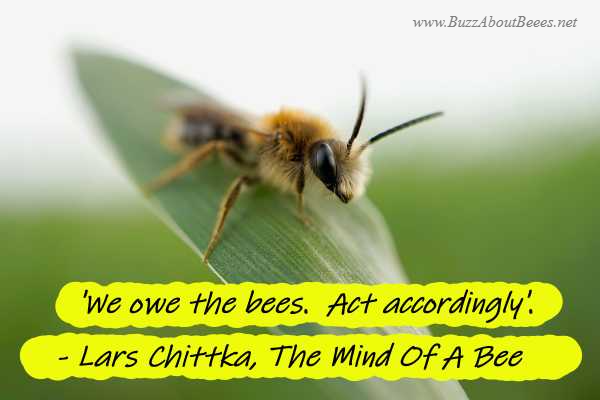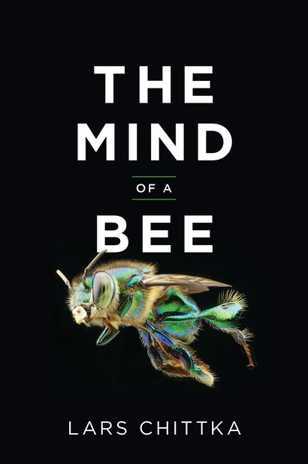Is It Okay To Kill Bees In Order To Study Them?
There are ways to study bees, without killing them. Please, let's not kill bees unnecessarily.
[Note: This page was written in 2018, and updated in 2023 to include notes from Chittka's 'Mind Of A Bee']
Scientists – even on the conservation side, can seemingly be rather detached from nature. Some would argue that this is necessary in order to produce an objective study, but I’m not sure that this is necessarily true.
The attitudes of having love, regard and respect for the lives of other creatures, and objectivity, are not automatically mutually exclusive. Why should they be?
Nature And Wildlife Species As 'expendable objects'?
My impression is that some people may look at nature and at other living creatures, as simply ‘expendable objects of study’ and that’s about it. (I use the term 'object' deliberately rather than 'subjects' of a study).
This attitude can extend to a disconcerting disregard for life, and even at times, an alarming view that taking the life of a creature in order to study it is automatically justified.
Perhaps it’s a symptom of the general sort of disconnect between humans and nature.
Yet we now know that bees can feel pain.
Furthermore, it has been shown that bees have feelings.
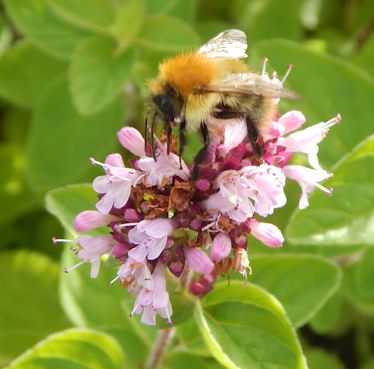 Common carder bumble bee on oregano / marjoram.
Common carder bumble bee on oregano / marjoram.Many scientists perform very important work, and I genuinely don't wish to denigrate that work in any way, but it seems to me that there are many scenarios in which bees and other insects are trapped and killed, whereas perhaps such activity could be minimized?
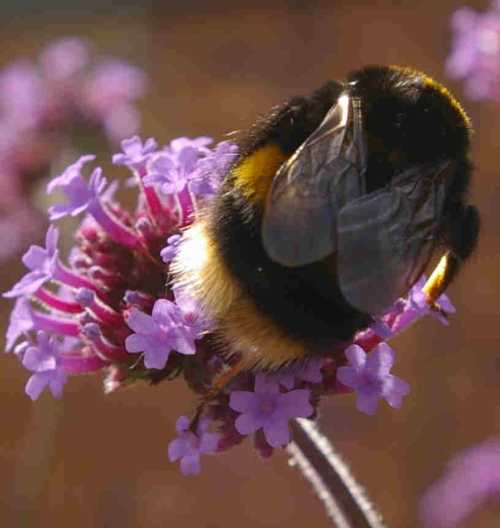 Buff-tailed bumble bee on verbena.
Buff-tailed bumble bee on verbena.How can bees be studied without killing them?
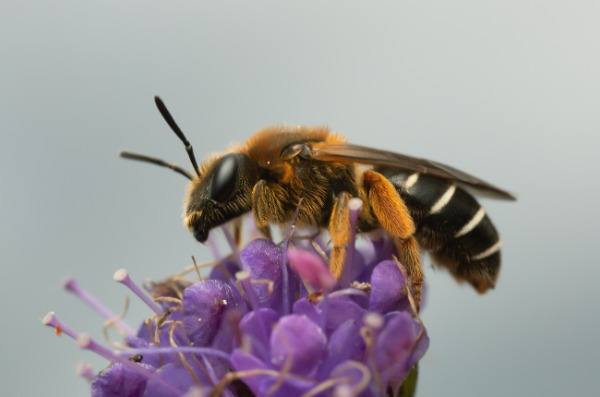 Orange-legged furrow bee on devil's-bit scabious
Orange-legged furrow bee on devil's-bit scabiousHere are a few points I feel could be considered:
- Perhaps there are occasions when already dead bee specimens can be used for study, for example, when students need to study
anatomy, and specifically dissect bees.
Dead bees can easily be found at the end of the ‘bee season’ and will have died from natural causes such as predator attack or age. I frequently find a few dead bumble bees of various types, later in the year. Dead honey bees can be collected from beekeepers, and are found outside the hive. - Where dissections take place, could the process be filmed and shown to future students? Of course, students could dissect bees that died of natural causes, as described in the point above.
- Perhaps with careful consideration, it would be possible to reduce the overall number of specimens needed in certain study scenarios.
- Consider whether some dissections are really necessary. Has the study been done before, and would the findings really matter?
For example, the honey bee has been widely studied, and its anatomy is well known. Is it really necessary to repeat exercises for the sake of it? Can study be supplemented by film?
Will the proposed study actually add real value to our knowledge in that it will make a positive difference in some area of life? If not, why bother? - Is it always necessary to kill and categorize? What is really gained, and is it useful?
Can differences between species and sexes be discerned in different ways, such as behavioural observations? - Quality
photographic images and film may also serve study purposes in many cases.
- Much scientific research is behavioural. Perhaps with vision, behavioural study can be applied in a more sophisticated fashion to areas where killing and dissection were traditionally deemed necessary?
- I also query any practice that involves the destruction of a wild colony for any purpose. By now, many techniques should surely have evolved to avoid such things, such as film (video).
Where seeking to provide quantitative data, measurement parameters could be devised to exclude the need to cause any damaging disruption to colonies.
I may be accused of being sentimental. I merely question the accepted wisdom that killing things to study them is the right approach, and whether it can automatically be considered as 'justified'.
If we accept this idea as 'the way it's done' how long will it take us to evolve better ways? (Necessity is the mother of invention after all!).
What kind of attitude do we encourage in young and new scientists, if they are educated to accept 'kill in order to study' as the automatic norm?
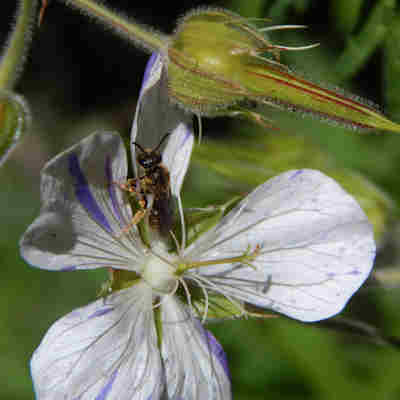 Orange-legged furrow bee (male) on geranium flower.
Orange-legged furrow bee (male) on geranium flower.I appreciate that in some cases, bees may be reared especially for this purpose - i.e. for the purpose of study, but I still feel uneasy about the killing.
Others may think this article contradicts my other stance on the killing of bees to test insecticides - another ethical dilemma, but I disagree, and that article needs to be read in its entirety to understand where I'm going with it.
Citizen
Science Projects And Bees
I welcome citizen science projects, however, I am alarmed when I see schemes (and books!) advocating that members of the public should/could capture live bees and pin them to a display board, and providing instructions for doing it. Additionally, a rare species may accidentally be lampooned.
This practice, in my view, is no better than collecting eggs, and collecting insects is exactly the kind of activity that fuels reprehensible behaviours, such as (sometimes illegal) trade in rare insects, including their sale on platforms such as Ebay - see Megachile pluto (Wallace's Giant Leafcutter bee), for example.
Instead, I would suggest that if identification rather than mere interest is the objective, then guidance needs to be given on taking photographs and video which will aid identification.
For example: capturing a good image and/or film of the hind legs especially, as well as the face and sides of the abdomen, can be shared with experts and will help for identification purposes.
I would also encourage authors writing study and I.D. guides to think about who may purchase the book (given the broader interest in bees) and whether it might be wiser to discourage capturing, killing and pinning bees rather than provide instructions on how to do so.
Surely for the serious student, these techniques should be covered by a university professor for the defined target audience - and such activities to be carried out only if it is necessary?
Final comment ....
Update: 2023
In 2022, I reviewed what for me, is the most ground breaking book about bees yet published - The Mind Of A Bee by Lars Chittka.
Readers interested in this subject should definitely read his book for the impressive research he has gathered.
However, for now, I wish to leave readers with several points he makes in the 'Afterword':
"The assessment of pain and emotional states in animals is a moral obligation in deciding strategies for animal welfare, for domestic animals and those hunted in the wild, as well as for animals used in laboratory experiments.....
However, current legislation in most countries places no limits on the treatment of invertebrates, on the assumption that they do not experience pain or emotions....
Given what we have learned [above] about the strong likelihood that bees have more than a basic nociception, and at least an elementary emotional life, this is clearly a deplorable state of affairs."
- Lars Chittka, The Mind Of A Bee
Meadowland
by
John Lewis-Stempel
A review of this beautiful nature diary
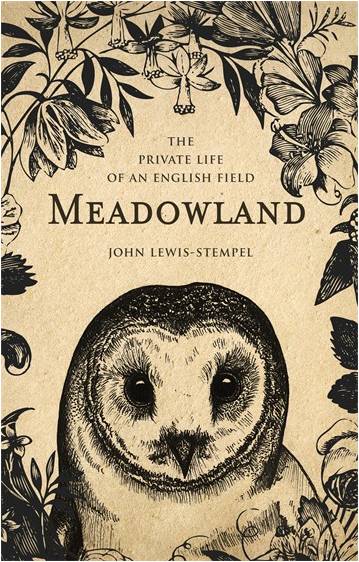
If you found this page helpful or interesting, I'd really be grateful if you would share it with others - if not this page, perhaps another, such as Gardening For Bees.
Thank you so much :) .
